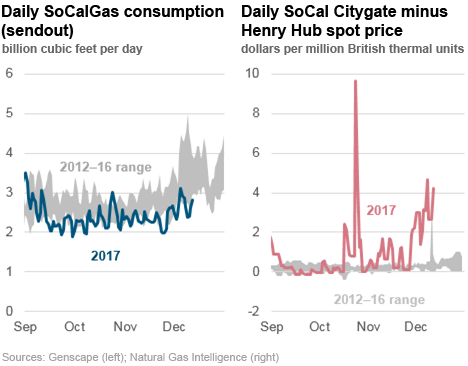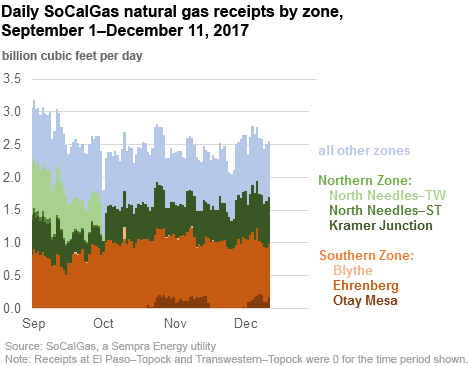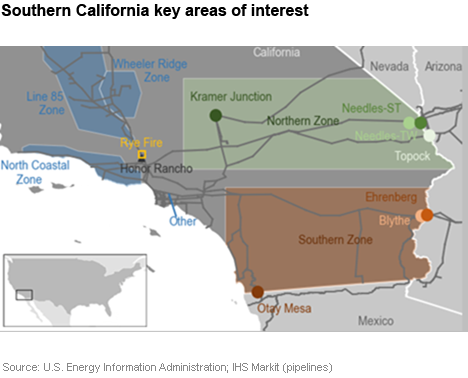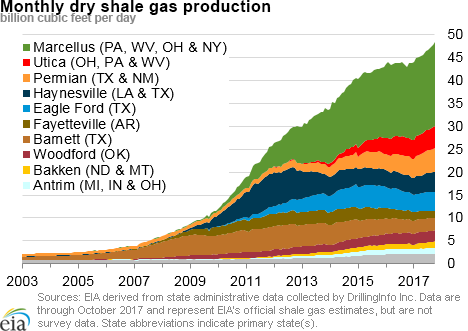Updated May 24, 2018 to correct typo in the price graph labeling.
In the News:
Southern California natural gas consumption is down, but SoCal Citygate prices are up with supply constraints
Wildfires in Southern California are the latest in a series of unrelated, overlapping events that have affected the area’s main local distribution system, operated by Southern California Gas Company (SoCalGas), since early October 2017.
Since October 1, natural gas consumption (sendout) on the SoCalGas system has been much lower than in prior years. From October 1–December 12, consumption averaged 13% lower than the five-year average for that time period. Despite lower consumption, the daily average spot price differential between SoCal Citygate and the U.S. benchmark Henry Hub was higher than the five-year maximum on 40 of the 73 days during that time period. Contributing to the increase in 2017 prices are planned and unplanned natural gas pipeline outages, local natural gas storage use restrictions, recent wildfires, and other infrastructure issues.
Most recently, the Rye Canyon fire directly affected the company’s Honor Rancho natural gas storage field in Santa Clarita by temporarily reducing withdrawal capacity by 55 million cubic feet per day (MMcf/d) from December 6–9. In addition, the Rye Canyon fire caused a two-day postponement in planned repairs to SoCalGas’s Line 2000. Line 2000 is currently operating at a 200 million cubic feet per day (MMcf/d) reduced capacity through the company’s Southern Zone.
Some of the other key natural gas outages affecting SoCalGas delivery to its customers include:
- October 1: A rupture on SoCalGas Line 235-2 in the Northern Zone has reduced deliveries to SoCalGas through the Northern Zone by 800 MMcf/d through December 25, with 450 MMcf/d remaining out of service indefinitely.
- November 16: An unplanned outage because of a natural gas quality issue reduced receipts from Transportadora de Gas Natural de Baja California (TGN) at Otay Mesa in the Southern Zone to zero through December 1.
- December 1: A force majeure on the Mojave Pipeline Company’s Mojave 2, has reduced capacity by 80 MMcf/d from December 1–31.
- December 5: Planned repairs on SoCalGas Line 2000 at Ehrenberg/Blythe in the Southern Zone reduced capacity by 200 MMcf/d from December 5–15 and will reduce capacity by 150 MMcf/d from December 18–20.
EIA provides a daily summary of key energy conditions in Southern California on the Southern California Daily Energy Report. In addition to the daily summary, EIA provides occasional commentary and analysis on notable market conditions in Southern California. For example, EIA provided a full summary of the events surrounding this October price spike in its November 9, 2017 commentary on the Southern California Daily Energy Report. This price spike caused the difference between the SoCal Citygate and Henry Hub prices (the basis) to reach a record high of $9.63 per million British thermal units ($/MMBtu) for delivery on October 24, 2017, when temperatures were much warmer than normal and consumption was more than 3 billion cubic feet (Bcf), or 17% higher than the five-year daily average consumption for October.
Overview:
(For the Week Ending Wednesday, December 6, 2017)
- Natural gas spot prices fell at most locations this report week (Wednesday, December 6 to Wednesday, December 13). The Henry Hub spot price fell from $2.92/MMBtu last Wednesday to $2.67/MMBtu yesterday.
- At the New York Mercantile Exchange (Nymex), the January 2018 contract price fell 21¢ from $2.922/MMBtu last Wednesday to $2.715/MMBtu yesterday.
- Net withdrawals from working gas totaled 69 Bcf for the week ending December 8. Working natural gas stocks are 3,626 Bcf, which is 5% less than the year-ago level and 1% lower than the five-year (2012–16) average for this week.
- The natural gas plant liquids composite price at Mont Belvieu, Texas, fell by 18¢, averaging $7.90/MMBtu for the week ending December 13. The price of ethane fell by 8%, while the prices of propane, butane, and isobutane all fell by 2%. The price of natural gasoline rose by 1%.
- According to Baker Hughes, for the week ending Tuesday, December 5, the natural gas rig count remained flat at 180. The number of oil-directed rigs rose by 2 to 751. The total rig count increased by 2 to 931.
Prices/Supply/Demand:
Prices fall outside the Northeast. This report week (Wednesday, December 6 to Wednesday, December 13), the Henry Hub spot price fell 25¢ from $2.92/MMBtu last Wednesday to $2.67/MMBtu yesterday. At the Chicago Citygate, prices decreased 29¢ from $2.91/MMBtu last Wednesday to $2.62/MMBtu yesterday, after reaching a weekly low of $2.63/MMBtu on Friday. Prices at PG&E Citygate in Northern California fell 6¢, down from $2.97/MMBtu last Wednesday to $2.91/MMBtu yesterday.
The price at SoCal Citygate decreased $1.90 from $6.02/MMBtu last Wednesday to $4.12/MMBtu yesterday. Prices at that location were volatile throughout the week with supply constraints and wildfires.
Prices rise in the Northeast. Colder weather persisted in New England and New York throughout the report week. At the Algonquin Citygate, which serves Boston-area consumers, prices increased $5.13 from $4.15/MMBtu last Wednesday to $9.28/MMBtu yesterday. At the Transcontinental Pipeline Zone 6 trading point for New York, prices increased $1.16 from $3.26/MMBtu last Wednesday to $4.42/MMBtu yesterday, with a weekly high of $5.65/MMBtu on Tuesday with colder-than-normal temperatures.
Mid-Atlantic temperatures moderated towards the end of the report week. Tennessee Zone 4 Marcellus spot prices decreased 36¢ from $2.37/MMBtu last Wednesday to $2.01/MMBtu yesterday. Prices at Dominion South in northwest Pennsylvania fell 42¢ from $2.54/MMBtu last Wednesday to $2.12/MMBtu yesterday.
Nymex prices fall. At the Nymex, the price of the January 2018 contract decreased 21¢, from $2.922/MMBtu last Wednesday to $2.715/MMBtu yesterday. On Tuesday, the January contract was $2.678/MMBtu, the lowest price for a front-month contract since February 24, 2017. The price of the 12-month strip averaging January 2018 through December 2018 futures contracts declined 17¢ to $2.723/MMBtu.
Supply remains steady. According to data from PointLogic Energy, total supply of natural gas remained the same as the previous report week, averaging 82.0 Bcf/d. Dry natural gas production remained constant week over week. Average net imports from Canada increased by 8% from last week.
Demand rises significantly. Total U.S. consumption of natural gas rose by 27% compared with the previous report week, according to data from PointLogic Energy. Natural gas consumed for power generation climbed by 18% week over week. Industrial sector consumption increased by 8% week over week. In the residential and commercial sector, consumption increased by 50% as a cold front moved across the country, and some areas in the southern United States received snowfall. However, residential and commercial demand was 1% lower than the same time last year. Natural gas exports to Mexico increased 4%.
U.S. liquefied natural gas (LNG) exports are flat week over week. Four LNG vessels (LNG-carrying capacity of 14.8 Bcf combined) departed the Sabine Pass liquefaction facility last week (Thursday to Wednesday) and two tankers (LNG-carrying capacity of 7.2 Bcf combined) were loading at the terminal on Wednesday.
The Dominion Energy Cove Point liquefaction terminal in Lusby, Maryland, has continued commissioning activities after introducing feed gas in early December. The facility is expected to be operational in early 2018, according to Bloomberg. Cove Point will become the second liquefaction terminal in the Lower 48 states and the only LNG export terminal on the U.S. East Coast.
Storage:
Below normal withdrawals result in declines to year-ago and five-year average deficit levels. Net withdrawals from storage totaled 69 Bcf for the week ending December 8, compared with the five-year (2012–16) average net withdrawal of 78 Bcf and last year's net withdrawals of 132 Bcf during the same week. Working gas stocks totaled 3,626 Bcf, which is 27 Bcf less than the five-year average and 201 Bcf less than last year at this time. The deficit to the five-year average declined for the fourth week in a row. Most of the deficit to the five-year average can be attributed to the Pacific region, where working gas stocks were 39 Bcf lower than their five-year average levels this week. Working gas levels in the East and Midwest regions—where natural gas is an important fuel for space and water heating—were 6 Bcf lower than and 16 Bcf higher than the five-year average, respectively.
Falling temperatures result in increased withdrawals of natural gas from storage. Colder weather throughout the Lower 48 states during the storage week resulted in increased consumption of natural gas. Although temperatures remained higher than normal for the report week, they posted significant declines compared with the previous week, when EIA reported an unusual December net injection for the Lower 48 states. Substantial increases in natural gas consumption in the power and residential/commercial sectors during this storage week resulted in withdrawals from storage in every region of the Lower 48 states, excluding the South Central salt region.
The January 2018 futures price traded at a premium compared with the current spot price. During the most recent storage week, the average natural gas spot price at the Henry Hub was $2.87 per million British thermal units (MMBtu), while the Nymex futures price of natural gas for delivery in January 2018 averaged $2.93/MMBtu, a difference (the premium) of 6¢. The premium was 1¢ a year ago.
Reported net implied flows into storage were near the upper end of analysts’ expectations. According to the Desk survey of natural gas analysts, estimates of the weekly net change in working natural gas storage ranged from net withdrawals totaling 52 Bcf to 69 Bcf, with a median net withdrawal of 60 Bcf. Prices for the futures contract for January delivery rose about 2¢/MMBtu, averaging $2.71/MMBtu, at the release of the Weekly Natural Gas Storage Report (WNGSR), with 165 contracts traded. However, prices declined in subsequent trading to $2.67/MMBtu—about 2¢ lower than the pre-release price.
Temperatures were higher than normal during the storage week in most of the Lower 48 states. Temperatures in the Lower 48 states averaged 45 degrees Fahrenheit (°F), 5°F higher than the normal and 2°F higher than last year at this time. Although temperatures were warmer than normal, temperatures posted declines compared to last week’s levels.
See also:
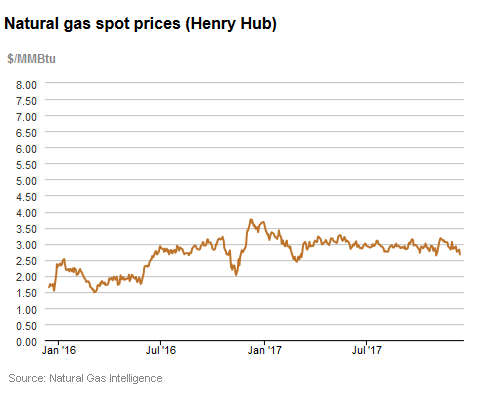
| Spot Prices ($/MMBtu) | Thu, 07-Dec |
Fri, 08-Dec |
Mon, 11-Dec |
Tue, 12-Dec |
Wed, 13-Dec |
|---|---|---|---|---|---|
| Henry Hub |
2.81 |
2.75 |
2.80 |
2.82 |
2.67 |
| New York |
3.95 |
4.17 |
3.77 |
5.65 |
4.42 |
| Chicago |
2.70 |
2.63 |
2.78 |
2.73 |
2.62 |
| Cal. Comp. Avg.* |
2.80 |
2.71 |
2.87 |
2.85 |
2.78 |
| Futures ($/MMBtu) | |||||
| January Contract | 2.763 |
2.772 |
2.828 |
2.678 |
2.715 |
| February Contract |
2.782 |
2.792 |
2.847 |
2.694 |
2.732 |
| *Avg. of NGI's reported prices for: Malin, PG&E Citygate, and Southern California Border Avg. | |||||
| Source: NGI's Daily Gas Price Index | |||||
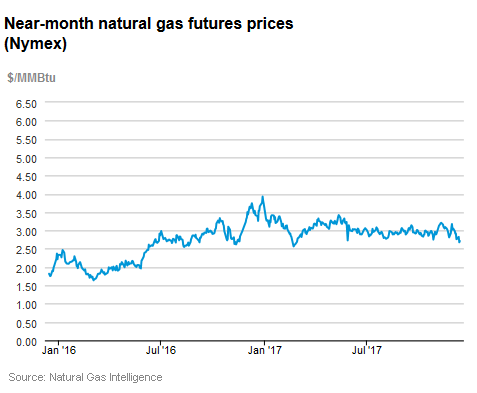
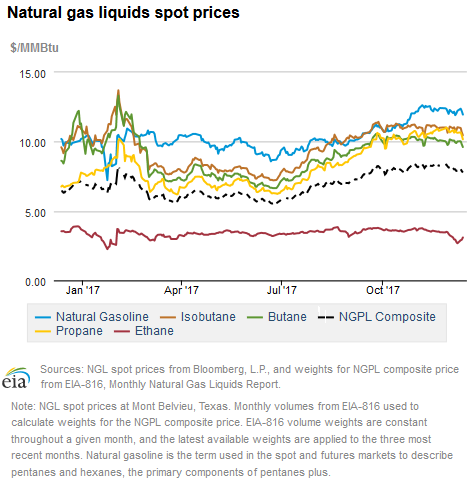
| U.S. natural gas supply - Gas Week: (12/7/17 - 12/13/17) | |||
|---|---|---|---|
Average daily values (Bcf/d): |
|||
this week |
last week |
last year |
|
| Marketed production | 84.7 |
84.9 |
78.4 |
| Dry production | 76.1 |
76.1 |
70.0 |
| Net Canada imports | 5.7 |
5.3 |
5.8 |
| LNG pipeline deliveries | 0.2 |
0.2 |
0.2 |
| Total supply | 82.0 |
81.6 |
76.0 |
|
Source: OPIS PointLogic Energy, an IHS Company | |||
| U.S. natural gas consumption - Gas Week: (12/7/17 - 12/13/17) | |||
|---|---|---|---|
Average daily values (Bcf/d): |
|||
this week |
last week |
last year |
|
| U.S. consumption | 91.4 |
71.9 |
89.0 |
| Power | 27.5 |
23.3 |
24.8 |
| Industrial | 23.2 |
21.5 |
23.1 |
| Residential/commercial | 40.7 |
27.2 |
41.1 |
| Mexico exports | 4.3 |
4.1 |
3.5 |
| Pipeline fuel use/losses | 7.9 |
6.3 |
7.7 |
| LNG pipeline receipts | 3.1 |
3.0 |
1.3 |
| Total demand | 106.7 |
85.3 |
101.5 |
|
Source: OPIS PointLogic Energy, an IHS Company | |||
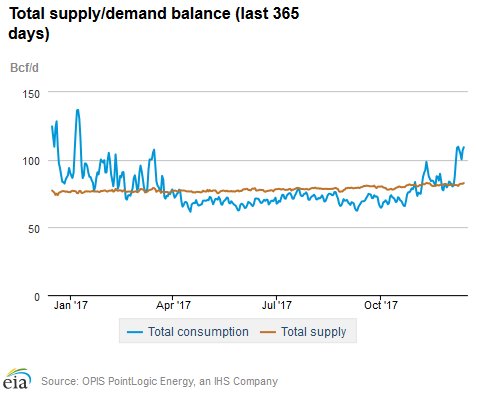
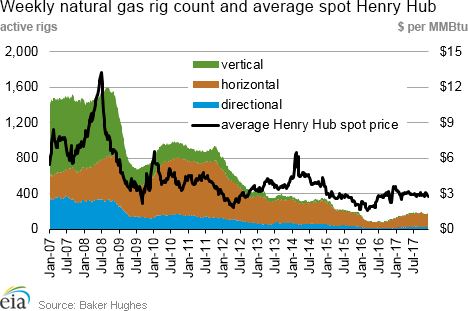
| Rigs | |||
|---|---|---|---|
Fri, December 08, 2017 |
Change from |
||
last week |
last year |
||
| Oil rigs | 751 |
0.3% |
50.8% |
| Natural gas rigs | 180 |
0.0% |
44.0% |
| Note: Excludes any miscellaneous rigs | |||
| Rig numbers by type | |||
|---|---|---|---|
Fri, December 08, 2017 |
Change from |
||
last week |
last year |
||
| Vertical | 64 |
-3.0% |
-8.6% |
| Horizontal | 796 |
0.5% |
58.3% |
| Directional | 71 |
0.0% |
39.2% |
| Source: Baker Hughes Inc. | |||
| Working gas in underground storage | ||||
|---|---|---|---|---|
Stocks billion cubic feet (Bcf) |
||||
| Region | 2017-12-08 |
2017-12-01 |
change |
|
| East | 855 |
868 |
-13 |
|
| Midwest | 1,033 |
1,058 |
-25 |
|
| Mountain | 213 |
221 |
-8 |
|
| Pacific | 305 |
313 |
-8 |
|
| South Central | 1,220 |
1,235 |
-15 |
|
| Total | 3,626 |
3,695 |
-69 |
|
| Source: U.S. Energy Information Administration | ||||
| Working gas in underground storage | |||||
|---|---|---|---|---|---|
Historical comparisons |
|||||
Year ago (12/8/16) |
5-year average (2012-2016) |
||||
| Region | Stocks (Bcf) |
% change |
Stocks (Bcf) |
% change |
|
| East | 870 |
-1.7 |
861 |
-0.7 |
|
| Midwest | 1,077 |
-4.1 |
1,017 |
1.6 |
|
| Mountain | 246 |
-13.4 |
209 |
1.9 |
|
| Pacific | 314 |
-2.9 |
344 |
-11.3 |
|
| South Central | 1,321 |
-7.6 |
1,222 |
-0.2 |
|
| Total | 3,827 |
-5.3 |
3,653 |
-0.7 |
|
| Source: U.S. Energy Information Administration | |||||
| Temperature – heating & cooling degree days (week ending Dec 07) | ||||||||
|---|---|---|---|---|---|---|---|---|
HDD deviation from: |
CDD deviation from: |
|||||||
| Region | HDD Current |
normal |
last year |
CDD Current |
normal |
last year |
||
| New England | 178 |
-31 |
3 |
0 |
0 |
0 |
||
| Middle Atlantic | 171 |
-27 |
16 |
0 |
0 |
0 |
||
| E N Central | 187 |
-41 |
-12 |
0 |
0 |
0 |
||
| W N Central | 203 |
-51 |
-15 |
0 |
0 |
0 |
||
| South Atlantic | 108 |
-31 |
-1 |
13 |
4 |
-6 |
||
| E S Central | 111 |
-31 |
-13 |
0 |
-1 |
-1 |
||
| W S Central | 73 |
-32 |
-25 |
10 |
7 |
10 |
||
| Mountain | 181 |
-32 |
-46 |
1 |
1 |
1 |
||
| Pacific | 94 |
-18 |
-26 |
0 |
-1 |
0 |
||
| United States | 146 |
-32 |
-13 |
4 |
2 |
0 |
||
|
Note: HDD = heating degree day; CDD = cooling degree day Source: National Oceanic and Atmospheric Administration | ||||||||
Average temperature (°F)
7-Day Mean ending Dec 07, 2017
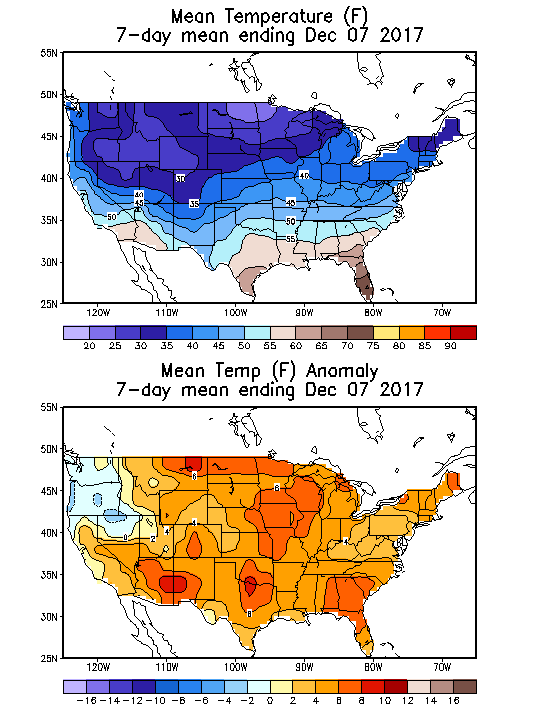
Source: NOAA National Weather Service
Deviation between average and normal (°F)
7-Day Mean ending Dec 07, 2017

Source: NOAA National Weather Service

